
Looking out from the small cave inside the main cave.

Looking out from the small cave inside the main cave.

At the east end of Holywell Bay and below Kelsey Head can be found the Holywell that gives the area its name. Only reachable at low tide, the well or wells are found inside a large cave that can not be seen from the main part of the beach.
Many pools have been formed by natural build up of minerals more in common with the mendip cave systems.
How and when they got the name holy well I am not sure but as with many of the other wells in Cornwall there origins are pre Christian.
I great place to escape from the excesses of Newquay or Perranporth.
At Holywell, or St. Cuthbert’s well, in Cubert [..] there is a well, or spring of fresh water, in a cavern on the sea shore. Thither on Holy Thursday children from the neighbourhood are carried, passed through a narrow fissure in the rock, and then immersed in a well, or font, excavated just beneath. This ceremony is traditionally said to be for the benefit of the child in soul and body.
Included for its stoney connection, from p241 of ‘The cross and the serpent’ by William Haslem (1849), which is readable on Google Books:















































